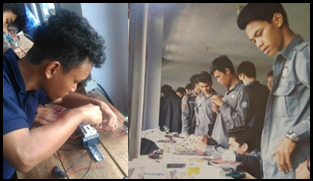Main Article Content
Abstract
The application of Occupational Safety and Health (OSH) is essential in vocational institutions that have a high risk of accidents. Therefore, this study aims to evaluate the application of OSH in the Electrical Laboratory of Subang State Polytechnic using a qualitative descriptive method through observation and interviews. The results of this study indicate that aspects of the application of the standard Personal Protective Equipment (PPE) and the use of practical work standards have a score of 66.25% and 62.5%, respectively. Meanwhile, the application of room standards seen from the four main indicators, namely furniture, equipment, educational media, and supporting equipment obtained a total score of 91% (high feasibility). In conclusion, the application of the PPE standard and practical work standard must be considered in detail to improve the overall OSH score.
Keywords
Article Details
References
- H. Sofyan and A. Efendi, “Implementation of Teacherpreneurship on Teachers at Vocational High School,” in Proceedings of the International Conference on Technology and Vocational Teachers (ICTVT 2017), 2017, vol. 102, pp. 229–236.
- C. Chatigny, J. Riel, and L. Nadon, “Health and safety of students in vocational training in Quebec : a gender issue ?,” vol. 41, pp. 4653–4660, 2012.
- Basori, “The Evaluation of Occupational Health and Safety (OHS) Implementation in Vocational High School Workshop, Surakarta,” in Proceedings of the International Conference on Indonesian Technical Vocational Education and Association (APTEKINDO 2018), 2018, vol. 201, pp. 121–125.
- I. Monney, D. Bismark, and O. Isaac, “Occupational health and safety practices among vehicle repair artisans in an urban area in Ghana,” Journal of Environmental and Occupational Science, vol. 3, no. 3, pp. 147–153, 2014.
- B. Endroyo, B. E. Yuwono, and D. Mardapi, “Model of Learning/Training of Occupational Safety & Health (OSH) Based on Industry in the Construction Industry,” Procedia Engineering, vol. 125, no. April 2016, pp. 83–88, 2015.
- R. Markey et al., “Improving productivity through enhan cing employee wellbeing and participation,” in Joint LEW13/ALMRW Conference, 2008, pp. 516–523.
- A. Efendi and D. Komarudin, “Evaluation of the Application of Occupational Safety and Health (OSH) at the Subang State Polytechnic Laboratory,” Automotive Experiences, vol. 2, no. 1, pp. 9–14, 2019.
- B. O. Alli, Fundamental Principless of Occupational Health and Safety, Second. Ganeva: International Labour Office, 2008.
- L. H. Yee and H. M. E. A. AL-Rejal, “Occupational Safety and Health Practices in Manufacturing Industry,” in Proceedings of Symposium on Technology Management & Logistics (STML–Go Green), 2016, pp. 782–792.
- H. Nasrullah, “Pembuatan dan Pengujian Media Pembelajaran K3 (Keselamatan dan Kesehatan Kerja) Berbasis Android,” Automotive Experiences, vol. 1, no. 2, pp. 53–57, 2018.
- D. Zhao and J. Lucas, “Virtual reality simulation for construction safety promotion,” International Journal of Injury Control and Safety Promotion, vol. 22, no. 1, pp. 57–67, 2015.
- A. Cohen and M. J. Colligan, “Assessing Occupational Safety and Health Training,” Ohio, 1998.

